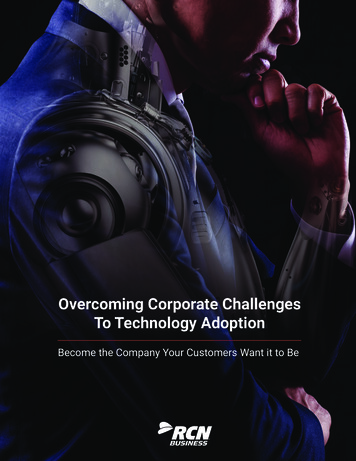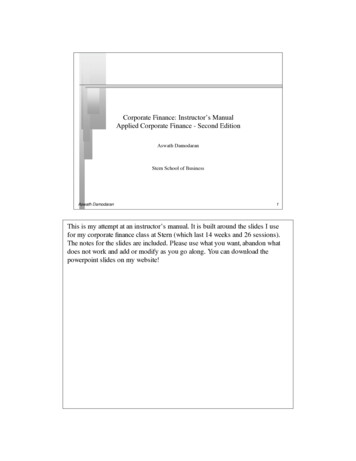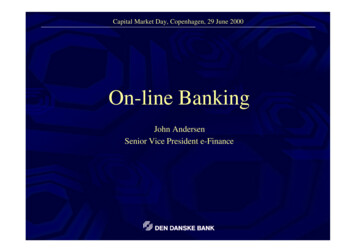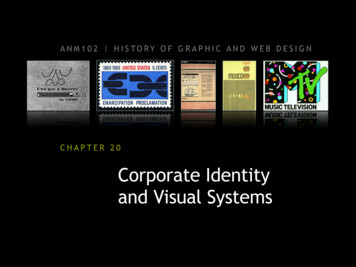
Transcription
Overcoming Corporate ChallengesTo Technology AdoptionBecome the Company Your Customers Want it to Be
Executive SummaryEvery organization faces challenges when implementing technologies that will change the status quo. Thereare cultural challenges that discourage stakeholders from taking risks and there are procedural and workflow challengesthat lead employees to question the value of a project. There are barriers to technology adoption that must be brokenand mindsets that must be changed in order to become the company your customers want it to be.In an effort to inform, educate and share knowledge to help CIOs identify and overcome these challenges, RCN/Grande/Wave has been sponsoring invitation-only networking dinners in our core markets entitled The Future of IT.Sanjog Aul, Founder of CIO Talk Network (CTN) and author of the book The Tricycle Way,moderates these dynamic, informative discussions among local CIOs about the trends,challenges and changes facing the enterprises today as they embark on their respectivedigital journeys.This white paper captures the highlights of some of the nuggets the CIOs sharedincluding most pressing issues they have to overcome, as well as several actionitems they are implementing to meet these challenges for a successful digitaltransformation. These topics by no means represent the scope of the discussions, andthis summary only scratches the surface of these free-flowing exchanges. We inviteyou to participate firsthand at the next Networking CIO Dinner in your city to take a deeperdive into The Future of IT.Sanjog Aul, pictured here, at an event supported by CIO Talk Network
Become The Company Your Customers Want It To BeLearning, change and the evolution of best practices often come from the active exchange of ideas and experiencesamong peers. Given this premise, RCN/Grande/Wave conducts a series of workshops in which CIOs discuss theirgreatest challenges to – and possible solutions for – successful technology adoption in the age of digital transformation.Innovation exists – or is stifled – by how a company reacts to change; or on a more granular level, how individualswithin the organization respond to changes in their roles, responsibilities and processes. To become the company yourcustomers want it to be – one that engenders trust and loyalty – change must be embraced at all levels. The reward iscontinued prosperity for the organization and fulfilling careers for you and your IT staff.Moderated by Sanjog Aul, a thought leader in the enterprise IT world and a consultant coach to C-level audiences, thefollowing is a summation of three of the most consistently raised issues among CIO attendees viewed from anorganizational context: Culture challenges, Process and Workflow challenges, and Technology Adoption challenges.Overcoming Company Culture Challenges, aka People & AttitudesCulture challenges prevent an organization from building an atmosphere conducive to change and allowingemployees to do their jobs better. Culture challenges can be the toughest to identify and solve because the issuesare often subjective and emotional in nature. What is a problem for one employee may be totally normal behaviorfor another; a solution praised by one may be unacceptable to others.Culture Challenge #1: Fear of FailurePerhaps the biggest inhibitor of innovation and creativity in a corporate environment is fear of failure. When peopleare resistant to try new things, are afraid to experiment with the status quo or are reluctant to even make a suggestionwhen there might be a better way, that stifles change. A brainstorming session in which participants keep their headsdown and ideas to themselves for fear of public shaming or other repercussions is neither productive nor comfortable.This may stem from a lack of leadership, when managers are not trusting of their subordinates, or conversely, whenteam members feel that management will not be accepting of ideas outside the box.Employees may worry that if they do something wrong they will get dinged on their performance review, lose a bonusor promotion. Maybe they witnessed someone getting fired for sticking their neck out and don’t want to be next. Theyare afraid of being embarrassed. So they clam up rather than speak up to try to do the right thing. Some people needexternal validation to build the confidence that their ideas will not be rejected out of hand or ridiculed. Then there isthe possibility of a bad hire; those who have low self-esteem and little value for their own input. They may be paralyzedby fear of failure to the point where inactivity and silence in the face of a glaring mistake seems reasonable.Corrective Action Item:Eliminate embarrassment and build trust through periodic team meetingswhere managers speak less and prompt the individual members to sharehow was the day/week, what exciting work did they do and if it did not work,what was the learning. Develop a nurturing atmosphere in which all teammembers feel comfortable expressing new ideas and views withoutrepercussions or ridicule.
Culture Challenge #2: Risk AversionWhy rock the boat? Closely related to fear of failure is the concept of risk aversion. It stems from complacency and the if itain’t broke don’t fix it line of thinking. When people are opposed to changing a system or process because what we havetoday works fine, innovation dies. It is the first sign of a company losing its edge. Often the reason for shelving an ideais the inability of stakeholders to visualize the full value of what the proposed solution could become, what the departmentcould become or what the company could become if they took the risk to do something differently.When the culture of an organization is risk-averse, it lacks the proper perception of cost versus benefit. The propensityto take a risk is reduced when the value of the benefit is not clear. If the proposed change results in no appreciable gainor savings, then any cost will make the initiative seem as if it will have a negative outcome to the stakeholder, diminishingthe chances of implementation.Corrective Action Item:Sometimes people need data to justify taking a risk. Encouragethinking outside the box to promote the development of improvedprocesses and procedures. When presenting ideas to stakeholders,elevate the level of benefit and the positive ROI of the businesscase by speaking to tangible, quantifiable benefits that outweighthe costs.Culture Challenge #3: Lack of TrustOftentimes the emergence of negative cultural patterns, such as fear of failure and risk aversion, have roots in thesame larger issue: a lack of trust. Similar to parenting, many manager-subordinate relationships have a mentoringcomponent. And just like parenting, the establishment of trust works both ways. There needs to be faith that whena task is delegated, it will be executed properly. Confidence builds trust. If problems arise, they can be brought toleadership’s attention and questions can be asked without assigning blame. Trust impacts lateral relationships as well.A lack of trust among team members can lead to poor communications, redundancy and fractured relationships thatimpact overall team performance. In the extreme, people may fear someone – a manager or coworker – will steal theiridea and claim it as their own, so it never sees the light of day. Sometimes it’s not necessarily trust, but credibility. Aperson may sit on an idea because they believe management doesn’t have the will or political muscle to see it through.Employees who have a lack of trust in management fear they will be judged or lectured, so they stop volunteeringinformation. Managers who have a lack of trust in their employees’ ability to execute a project will sit in their ivorytowers formulating plans and dole out tasks without input from staff, further diminishing employee trust inmanagement’s decisions.Corrective Action Item:We’re all in this together. Instill the notion of teamwork and thateveryone is here to help one another be successful. Your gain is ourgain. My win is your win. When a team member comes to you withan issue, be empathetic. Listen, don’t lecture, and validate the concern.When everyone believes someone has their back, great things happenas a team.
Overcoming Process & Workflow Challenges, aka Show Me The MoneyThe company has a process in place to manufacture or assemble its product. There is a system for communicatingwith customers and how that data is handled. There are proper channels and steps through which a purchase orderis approved or how expense reports are submitted. These are all examples of workflows, and all workflows should beperiodically reexamined to see which steps can be modernized, merged or eliminated to improve performance. One trappeople fall into is skipping or condensing steps to increase efficiency at the expense of quality. It’s one thing to reengineera process to make it more efficient, but it is another to affect that change without increasing costs or impacting quality.To be able to exploit the full value of what digital technology can bring to the table, organizations must be open tochanging processes and workflows.Process & Workflow Challenge #1: Lack of IncentiveHave you ever asked, Why aren’t we taking a fresh look at this process to see how we can achieve better outcomes?The answer usually is a lack of incentive. There has to be a payoff to the change that people can get behind, or theeffort will be doomed to failure – if it gets off the ground at all. People balk at investing time and effort into workflowand process rethinking when there is no perceived benefit beyond what the present system offers. They’ve already gotenough to do. Change for the sake of change is resisted.What’s in it for me? is the question most people ask. If the net result is producing fundamentally the same product orservice and the team has to alter a proven system without a reduction in hours, less stress or responsibilities, or anincrease in compensation, there is no incentive for change. People challenge the proposal when they do not see achange in outcome or a tangible benefit. When people get the most for doing the least, inertia results.Corrective Action Item:When revisiting a workflow, sketch out a proof of concept and test theories on paper first to determine how much timeor effort will be saved. Perform a dry run, making zero investment in the change until the business case is proven tomanagement. Get team members on board by providing specific examples of how their daily routines will be improvedby adopting the change. Explore the concept of building Digital Twins that’s successfully used in manufacturing industry.
Process & Workflow Challenge #2: Unwilling/Unable to Get Out of the Comfort ZoneMany companies go out of their way to create a comfortable work environment for employees. We’re not talking aboutping pong tables and couches in the break room; in this context we are referring to the company’s ability to build anatmosphere that fosters personal growth and self-actualization. Employees are entitled to a rewarding career. Theyshould feel empowered to make a difference to help a customer or coworker move a project forward to learn somethingnew every day. When a person feels valued, they are motivated to push the limits of their abilities – or knowledge – tothe next level to achieve something they previously believed beyond their reach. A win-win for the individual and the company.When employees get too comfortable, laziness sets in. They will not look past the limits of current systems ortheir own skill sets to address either a problem or an opportunity. Too much work; that’s above my pay grade. Or,they simply may be intimidated by the task. Management may be partially at fault here by inadvertently creating anenvironment that rewards complacency. I’ll just do what I’ve always done. Can’t get in trouble for that. If the sentimentto improve, to have an impact, to create value every day is not present in the individual, the department or thecompany, management will see pushback on any attempt to change processes and workflows.Corrective Action Item:Offer team members opportunities to improve themselves, be itthrough continuing education, cross-training, or simply on-thejob osmosis. Introduce job rotation as part of development plan.Explain how they will benefit and advance their career by learningsomething new.Process & Workflow Challenge #3: Unconvincing ROI ArgumentsThis is the flip side of Lack of Incentive. Rather than convincing subordinates of the benefits of adopting a change, thischallenge is about selling the value of a change to company leadership. Chances are you’ll be presenting to multiplestakeholders and the decision will be made by committee – a committee whose members may have differing agendasand levels of understanding. The reason why many projects never make it out of committee is because the championwas unable to build a solid business case.IT managers who doubt management’s ability to understand complex technology issues sometimes fall into the trapof positioning gains as relative to the current situation. The system will perform faster. We’ll experience less downtime.Our customers will be happier. But faster, less downtime or happier than what, exactly? Do you have a measure forhow many extra boxes the company will make or sell, or a metric of customer retention that will be improved by thechange? If not, there are very few businesses that will implement a change based on soft ROI. If you want buy-in, givequantifiable facts and figures to back up the proposal. If we do this, the company will meet its objectives of A, B and C.That makes it much easier for stakeholders to say, Okay, that makes sense, let’s move forward.Corrective Action Item:Ask yourself, if the situation were reversed, what would you need toknow before you buy in? Quantify the return on investment forstakeholders in terms they will clearly understand, such as areduction in the number of labor hours, a percentage increase inoutput or uptime, or an estimate of the incremental dollars savedor earned as a result of implementing the change. The key towinning is showing how everyone comes out ahead.
Overcoming Technology Adoption Challenges, aka Improve Yourself and the CompanyEvery day it seems as if there is another advancement in the ways we capture, compute and share digital information.But that doesn’t mean every employee is ready, willing and able to instantly grasp the functionality of a new tool orsystem upgrade. When technology is foisted upon unprepared people, it does not get used to its full potential, or at all.For example, a business may purchase a new CRM system, implement it and even spend considerable time and efforttraining employees on it. But if no one uses it, it’s just a waste of company resources.Technology Adoption Challenge #1: Lack of Skills/TalentThere’s a lot of churn and burn in the lower levels of the tech support world, especially in call center/customer serviceenvironments. Long hours, low pay and lots of pressure to resolve customer issues as quickly as possible leads to highturnover. Combined with an edict from management to minimize support costs, it can be difficult to find, train and retainthe right people. The result is often a team that, through no fault of its own, is underprepared to handle the complexitiesof the job. It’s not that they’re dumb, they simply have not been exposed to the technologies and scenarios that willenable them to do a better job.Let’s say there’s a new piece of software that would improve the way customer service reps could view multiple datapoints and provide intelligent answers to the customers they are trying to serve. If there is a perceived lack of skills inthe individuals who would use the software to analyze information, process it and respond to the customer in real time,it may be because they weren’t hired for that. It was never anticipated they would ever need to perform at that level –they were just meant to be order takers. So when the idea is pitched and the response is, Whoa that’s way too hard formy people, it usually never flies.Corrective Action Item:Hire for the right attitude and then provide training, more trainingand then train some more. Investing in employees makes themfeel valued. It encourages them to get out of their comfort zone,grow and learn something new. Don’t assume they can’t handle thetask. Assure stakeholders your team will be there to support endusers in a successful transition to the new solution.
Technology Adoption Challenge #2: Siloed ThinkingIt takes a village. Everyone in the organization ultimately is there to serve the customer. That what makes a businesssuccessful. Yet there are people who will challenge the need for a particular change because they don’t see how itimpacts their business unit. That is something that pertains more to finance; we’re HR, we don’t need that. So unifiedsupport for an idea does not exist because stakeholders are more concerned about their immediate span of controlrather than the entire company.Further, the network infrastructure of many enterprises is a hodge-podge of solutions and technologies from multiplevendors implemented over time. There may be proprietary bridges that connect silos, but each unit has evolved its ownway of doing business within the business. We use Solution A over here, they use a different platform in purchasing.Along comes someone who has a grand plan for transforming the network into a unified homogeneous environment,and no one can see the forest for the trees. A singular view for what is best for the company does not exist. Everyonewants to tweak the plan to minimize disruption to their business unit, and the proposed initiative either dies or doesnot get adopted in the way it should to deliver maximum value.Corrective Action Item:Creating an agile, unified network environment in which everyonehas access to necessary information at any time is the ultimategoal of digital transformation. When presenting a change that willimpact multiple business units, keep the focus on achieving umbrellacorporate objectives and gain consensus on how the solution willpositively impact each stakeholder as well as the company.Technology Adoption Challenge #3: A Solution Seeking a ProblemAs IT people, sometimes we become too enamored with our own technologies and capabilities. We get a new toy andstart imagining all the great things we can do with it. Wow, this is going to revolutionize how we do things. So we fast trackimplementation without properly vetting the solution. Will it really solve a problem? Was there one to begin with? Beingcool is not a reason to adopt technology.In the ultimate example of the tail wagging the dog, there are countless stories of IT recommending the latest and greatestsolutions to problems that don’t even exist yet, or the ROI was so small so as to make the implementation nearlyworthless. The hidden issue here is that this degrades management’s trust in IT in that they will bring only viable solutionsup for discussion, and not spend money on technology fortechnology’s sake. And so we circle back to Lack of Trust Corrective Action Item:You wouldn’t spend 1,000,000 to solve a 10,000 problem.Build the business case and determine the magnitude of theproblem, if the solution will affect the desired change, andif the ROI is truly there before committing. Don’t risk yourcredibility endorsing fringe solutions for small problems.
The Art of the PossiblePeople tend to lament what they lack. Why don’t we have that? Why can’t we do this? I don’t have that skill. Focusing onthe negative only creates resentment and more barriers to change. Conversely, if you open your mind to the possible — Howdo we get that? Can we do this? How do we get our people there? — then you will be more open to taking risks that canaffect positive change. Because risk is nothing more than our perception of cost versus benefit.While this paper focuses on issues affecting IT, the cultural, process/workflow and technology adoption challengesdescribed here transcend all business units in an organization. They affect individuals, entire teams and the companyas a whole. IT is often the one left holding the bag, having to rearrange its priorities to match changing business unitobjectives. But that shouldn’t preclude IT from taking proactive steps that can make the organization more agile andconducive to change in order to become the company your customers want it to be.Would you like to participate in the next Networking CIO Dinner in your city? Contact us at 609-751-9840 for schedulinginformation and to reserve your seat to this informative invitation-only event. 2020 RCN Telecom Services, LLC. All Rights Reserved. www.rcn.com/business
Overcoming Company Culture Challenges, aka People & Attitudes . Culture Challenge #1: Fear of Failure Perhaps the biggest inhibitor of innovation and creativity in a corporate environment is fear of failure. When people are resistant to try new things, are afraid to experiment with the status quo or are reluctant to even make a suggestion .










